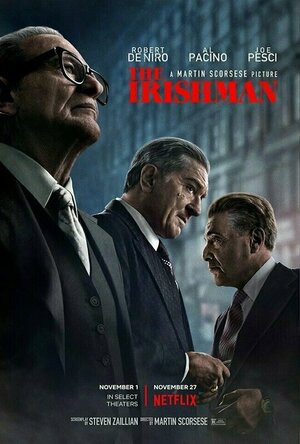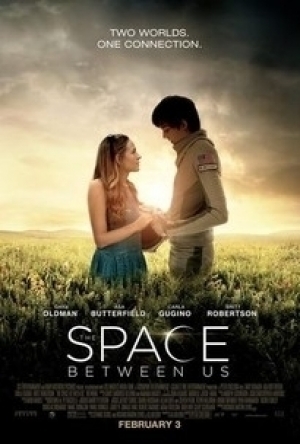BankofMarquis (1832 KP) rated The Irishman (2019) in Movies
Nov 30, 2019
There is a terrific film in this 3 1/2 hour epic - if only "Marty" would have trimmed the fat to find it.
Telling the real-life story (with some conjecture and fabrications), THE IRISHMAN tells the tale of...well...Irishman Frank Sheeran (Robert DeNiro) a working stiff who rises in the ranks of mobster Russell Buffalino (Joe Pesci) to be one of his chief enforcers and the personal bodyguard to Jimmy Hoffa (Al Paciino).
In the lead, DeNiro commands the screen like the DeNiro of old. His Frank Sheeran is menacing, razor-focused on his objectives. You never question Frank's loyalties and his ability to keep silent. DeNiro shows this by be being silent for a good part of this film, even though he is on screen for most of it. He is a commanding force that requires that we pay attention to him.
It was good to see Pesci back onscreen as Russell Buffalino. His mob boss is pragmatic, making decisions sternly and expecting his people to follow them, no questions asked. His presence on the screen is almost as commanding as DeNiro's and I wouldn't be surprised to see DeNiro (Best Actor) and Pesci (Best Supporting Actor) be in the mix come Oscar time.
In lesser, (almost cameo), roles - but faring very well - is a "who's who" of character actors, Harvey Keitel (who I would have LOVED to have seen much, much more in this film), Ray Romano, Bobby Canavale, Jesse Pleimens and Anna Paquin, I'm sure all jumped at the chance to appear - however briefly - in a Scorsese mob epic.
Faring less well in this film is Al Pacio as Jimmy Hoffa. He is back to his "yelling Al Pacino" ways of films like SCENT OF A WOMAN. His Hoffa is pretty one note and, consequently, his scenes with DeNiro are ineffective mostly because Pacino is chewing up the scenery (and yelling) while DeNiro is sitting silent and staring and listening to Pacino. This was a major disappointment for me, but (fortunately), Hoffa is in only about 1/3 of this long film, so while it hampered my enjoyment of the film, it didn't ruin it.
Credit (and blame) for all of this goes to master Director Martin Scorsese who has mined these waters more successfully in CASINO, THE DEPARTED and GOODFELLAS (his best film, IMO). This film is a loving pastiche to these types of films and a bygone era - and he chose to make it for NETFLIX for he wanted to make a sprawling epic and take his time in telling the story he wanted to tell. This is evidenced in the 3 1/2 hour length of this film, which if filled with long tracking shots set to a backdrop of Italian crooners singing old standards. It's a throwback to a different time and place, one that these players know well.
Scorsese has stated the he only decided to make this film because the "de-aging" software the he used to make DeNiro and Pesci look 30 years younger was "good enough" to use. And I would agree with that statement. The de-aging of these 2 (and others) is "good enough", in some scenes I forgot I was watching a de-aged DeNiro and Pesci, while in some other scenes, I could spot the trick. Again, it was "good enough" and not distracting (unless you were looking to make it distracting, then you probably found what you were looking for).
But for me - a fan of these types of films, I was not disappointed. It was about what I expected it to be. If you were looking for something different and new, look elsewhere, you will be disappointed.
Letter Grade: B+
8 stars (out of 10) and you can take that to the Bank(OfMarquis)
Ivana A. | Diary of Difference (1171 KP) rated Blood Shadow (Blood Never Lies 1) in Books
Feb 3, 2020
#1 <a href="https://www.goodreads.com/review/show/2401292193">Blood Shadow</a> - ★★★
<img src="https://diaryofdifference.com/wp-content/uploads/2019/10/Book-Review-Banner-25.png"/>;
<b><i>Blood Shadow (Blood Never Lies #1) is a companion novel for An Eye of The Storm Series.</i></b>
Blood Shadow can be read without reading the previous books. At the beginning, the author has included a recap of everything you need to know about the main character, before you start reading this book.
Blood Shadow was an interesting read, that is for certain. At the beginning I felt a bit lost in time and it took me awhile to understand what is going on, despite the recap that was provided by the author.
<i>A woman wakes up in a hospital and can't remember anything. Some anonymous person saved her life and gives her the name Jennifer, alongside with a whole new life.
She knows her real name is Selena. She also knows she was a werewolf but is not anymore. It seems she is human now, because her wounds are not healing as they usually would. Selena/Jennifer also remembers all the sexual abuse she went through before. Being tortured and raped and even persuaded to kill her brother. It feels like that was a lifetime ago.
And now, five years after her new life begun, she lives quietly and has a normal job and a boyfriend. The only thing that reminds her of her werewolf days are the sweaty nightmares. And now Jennifer has received a new note - on of those that her anonymous friend leaves for her now and then, advising her when she is in danger. But this time, the note says something different: a Supermoon is coming, and with that, a total lunar eclipse.</i>
This is the moment when things start to get confusing for me. There is an anonymous person, he sends her notes that have saved her life, he is always watching her, and now they need to meet, because she is in big danger and he has a secret to tell her. But he also doesn't want to reveal his true identity yet.
<b><i>[SPOILER ALERT]</i></b>
Long story short, he is one of the people that were there during her sexual abuse period. And he didn't do anything to help save her. Also, it turns out that she is also a mermaid, which is why she is able to do some things, but also doesn't have full powers.
And things keep being more and more confusing. From a werewolf story, we jump onto mermaids. The title also made me think that vampires bight be involved, which isn't the case. And we also might see dragons in the next book. I am not against having all these fantasy creatures into one place, but I felt that it needed to be explained better.
I felt for the girl - it must be extremely hard to live with such past and then to also have to constantly be hiding and never be truly happy. She tried to live a normal life as well, but just ended up hurting the people around her.
I am not sure that I connected enough with this book. The ending wasn't a conclusive one - it seemed as if it only was an opening for yet another book of the many. It didn't feel like any of the characters grew or learned from their past actions, which was slightly disappointing.
<b>It is a nice chill book to read in your spare time, if you like these types of books. But it is nothing out of the ordinary. I don't believe I will remember how it ended or what it was about in a few months.</b>
<a href="https://diaryofdifference.com/">Blog</a>; | <a href="https://www.facebook.com/diaryofdifference/">Facebook</a>; | <a href="https://twitter.com/DiaryDifference">Twitter</a>; | <a href="https://www.instagram.com/diaryofdifference/">Instagram</a>; | <a href="https://www.pinterest.co.uk/diaryofdifference/pins/">Pinterest</a>;

Anxiety Relief Hypnosis
Medical and Health & Fitness
App
◉ Learn to avoid anxiety and improve relaxation after listening daily for just 1–3 weeks ◉...
Bob Mann (459 KP) rated Frankie (2019) in Movies
May 24, 2021
Positives:
- Sintra looks gorgeous: as a regular visitor to Portugal's Silver Coast, it's a place I've not yet visited. The cinematography of the region makes me want to change that.
- There are a couple of decent scenes in the movie: both involving the trustworthy Greg Kinnear: one involving him trying to sell a film idea to Frankie (who knows, but won't tell him, that she won't be around for it); and another with Kinnear and Tomei at their hotel.
Negatives:
- Where do I start.... the film is as dull as dishwater!
-- A criticism I had of the otherwise impressive "Nomadland" was that the story arc of the leading character was shallow and not very compelling. The story arc here is a bloody straight line! Virtually nothing happens in the movie and it goes nowhere. Events occur as isolated snippets in the storyline. For example, the 'loss' of an expensive bracelet is randomly lobbed into the story, but then is never referenced back in any future narrative.
-- When the ending happened (which the illustrious Mrs Movie Man referred to as a "blessing") it was a non-event. The lady behind us in the cinema exclaimed "WHAT????". And I could understand her frustration.
- The direction is distinctly lacking. Aside from the couple of decent scenes (see above), most of the shots feel like first takes, with the actors doing read-throughs of the clunky script to try to work out how to best sell the lines. "OK, time to film it for real now". But director Sachs has already shouted "Cut and Print.... now who's for some more vinos and Pastel de Nata?"! Were they aiming for some sort of naturalistic fumbling of the character's conversations? For that's how it comes across, and it's just awful.
- The script feels like a wasted opportunity. The set-up should have been a good one for an intense drama. And there are flashes (merely flashes) of potential brilliance in there: a formative step-brother/step-sister incident is based around the film "Grease", which is mirrored (either cleverly or purely through coincidence!?) in the beach-side romance of Maya (Sennia Nanua) and Portuguese holiday-maker Pedro (Manuel Sá Nogueira). And does the homosexual Michel (Pascal Greggory) have his sights on Jimmy (Brendan Gleeson)? Or Tiago? Or both? None of these potentially interesting strands ever get tied down.
- Aside from the poor script and the poor direction, some of the acting performances are unconvincing. "The Girl with all the Gifts" was a fabulous film - it made my number 2 slot of 2016! And I called out young Sennia Nanua as "one to watch for the future" as the zombie girl at the heart of the film. Here she was 17 at the time of filming. But I'm afraid I just didn't find her convincing as the moody teen. (By the way, I only single her out, since I was so impressed with her previous performance: with the exception perhaps of Kinnear, Tomei and Carloto Cotta. none of the rest of the cast consistently shine either.)
Summary Thoughts: It's a real shame that my first visit back to the cinema was such a let-down. Ira Sachs is not a director I know, but he comes with a strong reputation (for 2016's "Little Men"). But here he delivers a plain stinker. I'm afraid this movie has a word associated with it, and the word is "Avoid".
(For the full graphical review, please check out "One Mann's Movies" here - https://bob-the-movie-man.com/2021/05/24/frankie-a-film-about-death-that-dies-on-its-feet/. Thanks.)
Gareth von Kallenbach (980 KP) rated The Space Between Us (2017) in Movies
Jul 12, 2019
Gardner finds a box of his mother’s things in a storage room and a photo of who he believes to be his father. His urge to go to Earth and meet his father and Tulsa is to the point he will do almost anything. Kendra seeing the pain that Gardner is in she decides to reach out to Genesis Director Chen (BD Wong) and founder Nathaniel Shepherd (Gary Oldman) and requests they allow him to come to Earth. Shepherd is against it. Pointing out that, due to the reduced gravity of Mars, Gardner’s bones will be weaker and more brittle and his heart will be enlarged. Almost assuredly making living on Earth impossible. Determined to make it to Gardner goes through painful operations to strengthen his bones and intense training to improve his muscles. After 16 years he is finally allowed to travel to Earth. Only to be quarantined and battered with tests upon arrival. Undeterred, he breaks out of the facility and heads out to find Tulsa. He finds her and convinces her to help him find his father. So they head out cross country to find his family and seem to be finding love along the way. But Kendra and Shepherd are hot on their heels. They rush to track Gardner down before his health deteriorates and is unable to survive in Earth’s environment.
The Sci-Fi story is a heartwarming one in The Space Between Us. It is a futuristic love story of two teens who are worlds apart, literally in this instance, but both find the one person in the universe who is meant for them. Butterfield does a good job of playing Gardner and showing how someone removed from this world can be awkward and out of place but also be amazingly honest and forthright. Robertson performance is okay as the tough product of a foster system teen that has a rough exterior but longs for a family. The love story and interaction between these two characters is definitely the bright spot. The rest of the cast is good and the overall story had some original concepts, such as the first human born on Mars. But there are times that are a little cheesy for my personal taste. Also the ending in my opinion was predictable and a forgone conclusion. How the film was presented visually was hit and miss for me. There would be beautiful shots of mountain passes, the ocean or the desert that really captured the beauty of Earth as if they were being seen for the first time. Then there were times when the shot was blurry and you could tell the people, vehicles or aircraft was out of place. The shots of space were very much the same some good some bad.
Overall the movie was good but not really something I would want to go back and see again. It definitely had the feel of a movie you could take the whole family to, very wholesome. I wish it was more constant visually.

Rota Calendar - Work Shift Manager
Productivity and Lifestyle
App
Sort your shift out - 8 reasons to get control back of your social life with Rota Calendar. Does...

Timeline Cover Photo Maker Free - Design and create your own custom Facebook profile page covers that reflects your personality!
Photo & Video and Social Networking
App
The App Store's most popular Cover Photo Making App for your Timeline now has a FREE version! ...

Natural Cycles, Birth Control
Health & Fitness and Medical
App
Natural Cycles helps you keep track of your ovulation, period and fertility. The app will show you...

Lose Weight Hypnosis
Health & Fitness and Lifestyle
App
◉ Learn to enjoy healthy food and exercise after listening daily for just 1–3 weeks ◉ Change...




